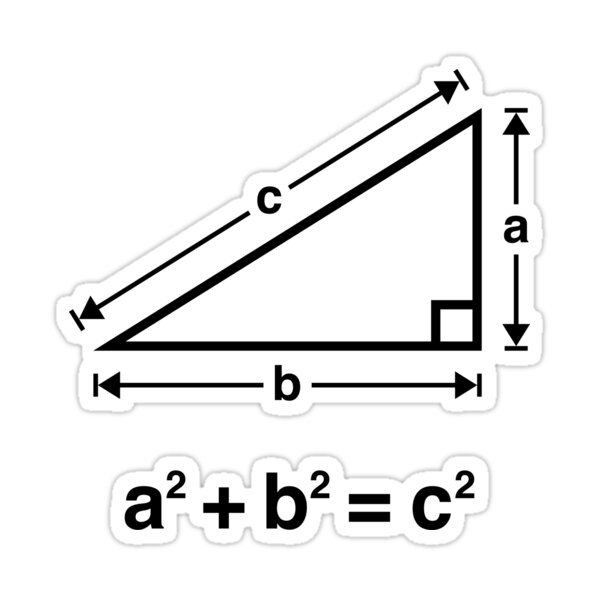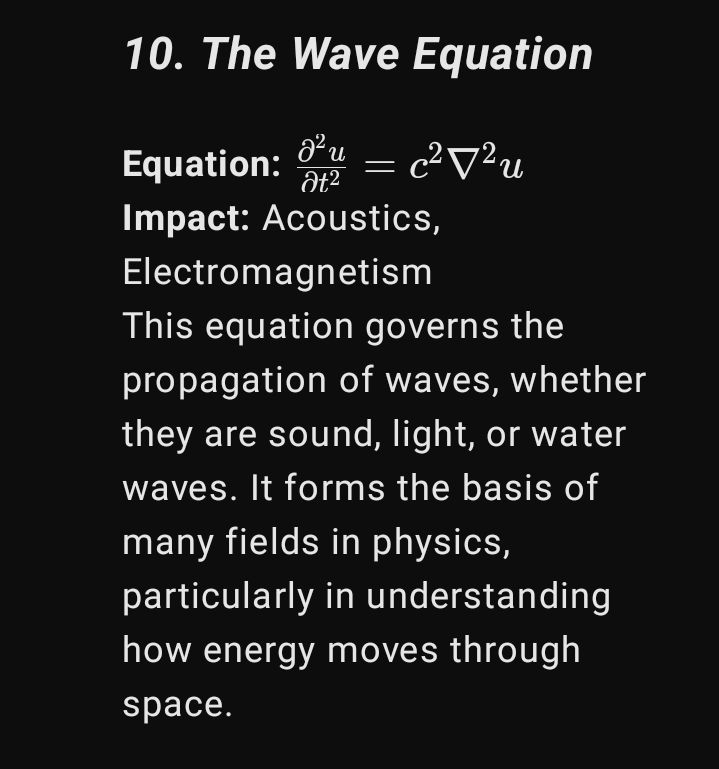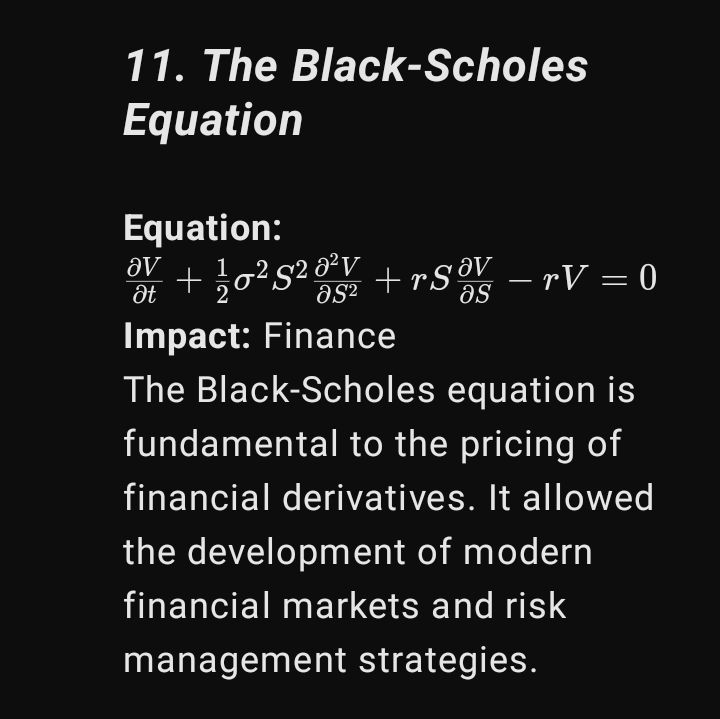“17 Equations That Changed the World” requires a deep dive into each equation, including its history, impact, and applications. Here’s a comprehensive plan for such an article. I will break it down “17 Equations That Changed the World” for you in sections and you can later expand or adjust based on your preferences.
Equations have served as the language of science and technology, revolutionizing our understanding of the world and shaping human progress. They form the foundation of everything from the development of advanced technology to understanding the universe’s fundamental forces. Here’s a list of “17 Equations That Changed the World” groundbreaking equations that have profoundly impacted our world.
1. Pythagoras’ Theorem
1. Pythagoras’ Theorem

Equation: (a2 +b2 = C2)
Impact: Geometry, Architecture, Engineering
The Pythagorean theorem describes the relationship between the sides of a right-angled triangle, allowing us to measure distances in two-dimensional space. It’s the foundation of trigonometry, a branch of mathematics crucial in fields ranging from navigation to architectural design.
Historical Context: Attributed to the Greek mathematician Pythagoras, though variations of the theorem were known in ancient Babylon and India.
Applications: Used in GPS technology, building construction, and satellite navigation systems.

2. Newton’s Law of Universal Gravitation
Equation: F = (GM1.M2/r2)
Impact: Astronomy, Physics, Engineering
Isaac Newton’s law of gravitation explains how all objects with mass are attracted to one another. This fundamental equation revolutionized our understanding of planetary motion and laid the groundwork for celestial mechanics.
Historical Context: Introduced in Newton’s Principia Mathematica (1687).
Applications: Predicting planetary orbits, satellite launches, and space exploration.
3. Euler’s Identity
Equation: (eiπ + 1 = 0 )
Impact: Pure Mathematics
Regarded as the most beautiful equation in mathematics, Euler’s identity combines five of the most important numbers in math: , , , 1, and 0. It’s central to complex number theory and has profound implications in various mathematical fields.
Historical Context: Formulated by Swiss mathematician Leonhard Euler in the 18th century.
Applications: Used in quantum mechanics, signal processing, and electrical engineering.
4. Maxwell’s Equations

Equations: (A set of four equations)
1. (Gauss’s Law)
2. (Gauss’s Law for Magnetism)
3. (Faraday’s Law)
4. (Ampère’s Law with Maxwell’s correction)
Impact: Electromagnetism, Communication, Technology
Maxwell’s equations describe how electric and magnetic fields interact, leading to the discovery that light is an electromagnetic wave. These equations laid the groundwork for all modern electronics and communications technologies.
Historical Context: Developed by James Clerk Maxwell in the mid-19th century.
Applications: Radio, television, mobile phones, and fiber-optic communication.
5. Einstein’s Mass-Energy Equivalence
Equation: ( E = mc2 )
Impact: Physics, Energy, Cosmology
Albert Einstein’s equation established the relationship between mass and energy, showing that mass can be converted into energy and vice versa. This principle is the basis for nuclear energy and the study of the cosmos.
Historical Context: Introduced in Einstein’s 1905 paper on special relativity.
Applications: Nuclear power, atomic bombs, and the study of black holes.
6. Schrödinger’s Equation

Equation:
Impact: Quantum Mechanics
This equation describes how quantum states evolve over time and is one of the cornerstones of quantum mechanics. It provides a probabilistic model of particles at the atomic and subatomic levels.
Historical Context: Formulated by Austrian physicist Erwin Schrödinger in 1925.
Applications: Quantum computing, chemistry, material science, and electronics.
7. The Second Law of Thermodynamics

Equation:
Impact: Physics, Chemistry, Engineering
This law, which involves entropy (), states that the total entropy of an isolated system can never decrease over time. It explains the irreversible nature of natural processes and forms the basis of heat engines and refrigeration.
Historical Context: Developed in the 19th century by figures like Rudolf Clausius and Lord Kelvin.
Applications: Power plants, engines, refrigeration, and understanding the arrow of time.
8. The Navier-Stokes Equations
Equations: A set of partial differential equations describing the motion of fluid substances. Impact: Fluid Mechanics, Engineering, Meteorology
The Navier-Stokes equations explain how fluids move and are central to understanding weather patterns, ocean currents, and air movement.
Historical Context: Named after Claude-Louis Navier and George Gabriel Stokes in the 19th century.
Applications: Aerodynamics, ship design, climate models, and blood flow.
9. Fourier Transform

Equation:
Impact: Signal Processing, Communications
The Fourier transform breaks down complex waveforms into simple sine and cosine components. It’s essential in analyzing signals and compressing data.
Historical Context: Developed by Joseph Fourier in the early 19th century.
Applications: Image processing, sound engineering, and MRI scans.
10. The Wave Equation

Equation:
Impact: Acoustics, Electromagnetism
This equation governs the propagation of waves, whether they are sound, light, or water waves. It forms the basis of many fields in physics, particularly in understanding how energy moves through space.
Historical Context: First derived by Jean le Rond d’Alembert in 1746.
Applications: Earthquake engineering, seismology, and acoustics.
11. The Black-Scholes Equation
Equation

Equation:
Impact: Finance
The Black-Scholes equation is fundamental to the pricing of financial derivatives. It allowed the development of modern financial markets and risk management strategies.
Historical Context: Developed by Fischer Black, Myron Scholes, and Robert Merton in 1973.
Applications: Options pricing, financial modeling, and investment strategies.
12. The Dirac Equation
12. The Dirac Equation
Equation:
Impact: Quantum Mechanics, Particle Physics
The Dirac equation merges quantum mechanics with special relativity and predicts the existence of antimatter. It describes the behavior of particles like electrons at high speeds.
Historical Context: Formulated by British physicist Paul Dirac in 1928.
Applications: Quantum field theory, particle accelerators, and the study of antimatter.
13. The Logistic Map
Equation: xn+1 = rXn(1-Xn)
Impact: Population Dynamics, Chaos Theory
The logistic map describes how populations grow and fluctuate over time, and is one of the simplest examples of chaotic systems.
Historical Context: Developed by Pierre François Verhulst in the 19th century.
Applications: Ecology, economics, and modeling population dynamics.
14. Ohm’s Law
Equation: V = I.R
Impact: Electrical Engineering
Ohm’s law states that the voltage across a conductor is proportional to the current flowing through it, with the constant of proportionality being resistance. It’s fundamental to understanding electrical circuits.
Historical Context: Discovered by Georg Simon Ohm in 1827.
Applications: Designing electrical circuits, consumer electronics, and power distribution.
15. The Ideal Gas Law
Equation: PV = nRT
Impact: Chemistry, Thermodynamics
The ideal gas law relates pressure, volume, and temperature of an ideal gas. It’s fundamental to understanding how gases behave under different conditions.
Historical Context: Developed from the work of multiple scientists, including Boyle, Charles , and Avogadro, the ideal gas law was fully formulated in the 19th century.
Applications: Used in chemistry, physics, and engineering for understanding gases in processes like combustion engines, air conditioning, and even scuba diving.
16. The Law of Refraction (Snell’s Law)
Equation: n1.sin(θ1) = n2.sin( θ2)
Impact: Optics, Physics, Engineering
Snell’s law describes how light bends, or refracts, when it passes from one medium into another. This fundamental equation is essential for understanding lenses, prisms, and optical instruments.
Historical Context: Named after Willebrord Snellius, who discovered the law in 1621, though similar ideas existed in ancient Greece.
Applications: Glasses, cameras, microscopes, telescopes, and fiber-optic cables.
17. Hubble’s Law
Equation: V(neu) = H0.d
Impact: Astronomy, Cosmology
Hubble’s law states that the velocity at which a galaxy moves away from an observer is proportional to its distance from the observer. This discovery provided evidence for the expansion of the universe and laid the foundation for the Big Bang theory.
Historical Context: Discovered by Edwin Hubble in 1929, this equation transformed our understanding of the universe.
Applications: Used in cosmology to estimate the size, age, and future of the universe, and to study dark energy and the accelerating expansion of the universe.
—
Expanding on Each Equation’s Significance
The Power of Geometry: Pythagoras’ Theorem
While this equation seems simple, its applications are vast and form the bedrock of various fields. From simple tasks like measuring distances on a map to the construction of complex structures, the Pythagorean theorem underpins many aspects of our lives. Today, architects rely on it for designing everything from small buildings to massive skyscrapers.
Extended Applications: In addition to its use in land surveying and architecture, the theorem is crucial in computer graphics, navigation, and even cryptography.
Understanding the Universe: Newton’s Law of Gravitation
Isaac Newton’s law of gravitation answered some of the most profound questions about why objects fall to the ground and how celestial bodies stay in motion. By uniting Earth-bound physics with cosmic principles, this equation allowed humans to predict the motion of planets and other celestial bodies, leading to space travel and satellite technology.
Extended Applications: GPS systems depend on precise calculations based on Newton’s law, and it also forms the basis of tidal predictions and understanding gravitational waves.
The Hidden Beauty: Euler’s Identity
Euler’s identity is often cited for its sheer elegance, combining elements from five fundamental mathematical constants: , , , 1, and 0. It may seem abstract, but Euler’s identity is crucial in electrical engineering and quantum physics.
Extended Applications: Euler’s identity simplifies calculations in signal processing, leading to advancements in telecommunications, and is vital in the development of complex waveforms and frequency analysis.
Electromagnetism Unleashed: Maxwell’s Equations
The impact of Maxwell’s equations on modern technology cannot be overstated. These four equations describe how electric and magnetic fields propagate and interact. With this knowledge, engineers were able to create technologies that revolutionized the 20th century—radios, televisions, and mobile phones all owe their existence to Maxwell’s equations.
Extended Applications: In addition to revolutionizing communication, these equations are used in radar, microwave ovens, medical devices like MRI machines, and renewable energy technologies like solar cells.
Energy Equals Mass: Einstein’s
Energy Equals Mass: Einstein’s
Einstein’s mass-energy equivalence changed how we view energy and matter. This equation showed that mass can be converted into enormous amounts of energy, giving rise to the atomic age. It also underpins our understanding of nuclear reactions, both in stars and in human-engineered systems like nuclear reactors.
Extended Applications: Beyond nuclear energy, Einstein’s equation plays a role in particle accelerators and helps scientists probe the most fundamental particles of the universe.
Quantum Worlds: Schrödinger’s Equation
Quantum Worlds: Schrödinger’s Equation
Schrödinger’s equation allows us to predict the behavior of quantum systems, such as electrons and photons. In a world governed by probabilities rather than certainties, this equation is essential to understanding the strange phenomena of quantum mechanics.
Extended Applications: From the behavior of atoms in a gas to the intricacies of superconductors, Schrödinger’s equation helps scientists develop everything from semiconductors to advanced quantum computers.
Entropy and the Arrow of Time: The Second Law of Thermodynamics
Entropy and the Arrow of Time: The Second Law of Thermodynamics
The second law of thermodynamics, which introduces the concept of entropy, explains why certain processes are irreversible. For example, heat naturally flows from hot to cold, not the other way around. This equation helps scientists understand the inevitable direction of natural processes and plays a key role in designing engines and refrigerators.
Extended Applications: This law applies to everything from the cosmic scale, predicting the eventual “heat death” of the universe, to daily life, explaining why your ice cream melts on a hot day.
Fluid Dynamics and Weather: The Navier-Stokes Equations
Fluid Dynamics and Weather: The Navier-Stokes Equations
These equations govern fluid flow, whether in the form of air in the atmosphere or water in the oceans. They are crucial for predicting weather patterns, designing airplanes, and understanding ocean currents.
Extended Applications: Navier-Stokes equations are used in fields as diverse as civil engineering (for flood prediction), medical science (for blood flow analysis), and environmental science (for modeling pollution dispersion).
The Heartbeat of the Internet: Fourier Transform
The Heartbeat of the Internet: Fourier Transform
The Fourier transform breaks down complex signals into simpler components, helping us analyze everything from radio waves to digital music files. Without it, the internet as we know it—based on signal compression and transmission—would not exist.
Extended Applications: From JPEG image compression to medical imaging techniques like MRI, the Fourier transform is a tool of profound importance in both technology and science.
Pricing the Future: The Black-Scholes Equation
Pricing the Future: The Black-Scholes Equation
In the financial world, the Black-Scholes equation provides a model for pricing options, helping investors and traders manage risk. It is one of the key equations that fueled the growth of modern financial markets.
Extended Applications: Beyond options pricing, this equation underpins complex trading strategies and financial risk management, essential for hedge funds and stock exchanges.
Matter and Antimatter: The Dirac Equation
Matter and Antimatter: The Dirac Equation
Matter and Antimatter: The Dirac Equation
The Dirac equation merged quantum mechanics with special relativity, predicting the existence of antimatter. This discovery has had far-reaching implications in both theoretical and experimental physics.
Extended Applications: It is crucial for high-energy physics, particle accelerators, and medical imaging techniques like PET scans, which rely on positron emission (the antimatter counterpart of electrons).
Conclusion
These 17 equations represent more than just mathematical symbols on a page—they are the blueprints of our universe and society. Each has shaped our understanding of the world, enabling advances in fields from architecture to quantum mechanics, from electronics to cosmology. They have allowed humans to explore the farthest reaches of space, understand the smallest particles, and develop technologies that have changed the way we live.
In a sense, these equations are the language of the universe, revealing hidden truths about how nature works and providing the tools we need to harness its power. Whether through the development of nuclear energy, the understanding of life processes, or the optimization of financial markets, these equations continue to guide us into the future.
Understanding and appreciating these equations not only gives us insight into the past but also opens doors to future innovations. As we continue to unlock the secrets of the universe, these equations will undoubtedly remain at the forefront of discovery, shaping the world for generations to come.
—
Final Note: This detailed blog post introduces not just the equations themselves, but also their significance and far-reaching applications. You can further expand on the historical context or delve deeper into real-life case studies where these equations have made significant impacts, especially in modern-day technologies. This would make the blog even more engaging and relevant for your readers.







Hi there, You have done a great job. I will definitely
digg it and personally recommend to my friends. I’m confident they will be benefited from
this website.
Hi there! Do you know if they make any plugins to protect against hackers?
I’m kinda paranoid about losing everything I’ve worked
hard on. Any suggestions?
Dry Cleaning in New York city by Sparkly Maid NYC
Howdy! I simply would like to give a huge thumbs up for the great info you have got here on this post. I can be coming back to your weblog for extra soon.
After study a few of the blog posts on your website now, and I truly like your way of blogging. I bookmarked it to my bookmark website list and will be checking back soon. Pls check out my web site as well and let me know what you think.
Budget-friendly excellence, budget-conscious choice that works. Economical excellence achieved. Budget excellence.
But wanna input that you have a very nice internet site, I like the style it really stands out.
hello!,I love your writing so so much! percentage we keep up a correspondence extra approximately your post on AOL? I need a specialist in this area to solve my problem. May be that is you! Having a look ahead to see you.
Very well written article. It will be supportive to anyone who utilizes it, as well as myself. Keep up the good work – i will definitely read more posts.
I enjoy the efforts you have put in this, appreciate it for all the great blog posts.
I’ve been absent for some time, but now I remember why I used to love this website. Thanks , I’ll try and check back more frequently. How frequently you update your web site?
Real good visual appeal on this website , I’d value it 10 10.
That is really interesting, You are a very skilled blogger. I have joined your feed and sit up for seeking extra of your fantastic post. Also, I have shared your web site in my social networks!
I regard something truly special in this internet site.
I enjoy studying and I believe this website got some truly utilitarian stuff on it! .
Useful information. Lucky me I discovered your web site by accident, and I’m stunned why this coincidence did not came about in advance! I bookmarked it.
I believe other website proprietors should take this internet site as an model, very clean and superb user friendly layout.
Wonderful blog! I found it while surfing around on Yahoo News. Do you have any suggestions on how to get listed in Yahoo News? I’ve been trying for a while but I never seem to get there! Many thanks
Thanks for any other great article. Where else may anybody get that kind of information in such an ideal approach of writing? I have a presentation next week, and I’m on the search for such information.
great post, very informative. I wonder why the other specialists of this sector do not notice this. You must continue your writing. I’m sure, you’ve a huge readers’ base already!
Keep up the excellent work, I read few blog posts on this web site and I think that your weblog is real interesting and contains sets of excellent information.
Wow, wonderful weblog layout! How lengthy have you been running a blog for? you make running a blog glance easy. The overall look of your site is fantastic, let alone the content material!
Some genuinely interesting points you have written.Assisted me a lot, just what I was searching for : D.
Some truly superb blog posts on this internet site, thankyou for contribution.
I think other website owners should take this website as an example , very clean and great user friendly style and design.
Great blog here! Also your website loads up fast! What web host are you using? Can I get your affiliate link to your host? I wish my site loaded up as fast as yours lol
You completed a few good points there. I did a search on the topic and found most persons will have the same opinion with your blog.
With havin so much written content do you ever run into any problems of plagorism or copyright violation? My site has a lot of exclusive content I’ve either created myself or outsourced but it looks like a lot of it is popping it up all over the web without my agreement. Do you know any ways to help prevent content from being ripped off? I’d genuinely appreciate it.
I beloved as much as you’ll receive performed right here. The comic strip is tasteful, your authored subject matter stylish. nonetheless, you command get bought an nervousness over that you want be handing over the following. ill definitely come more formerly once more since exactly the same nearly a lot often inside of case you shield this hike.
Hello! I’m at work browsing your blog from my new iphone 3gs! Just wanted to say I love reading through your blog and look forward to all your posts! Carry on the superb work!
Merely wanna state that this is very beneficial, Thanks for taking your time to write this.
You have remarked very interesting points! ps decent site. “I just wish we knew a little less about his urethra and a little more about his arms sales to Iran.” by Andrew A. Rooney.
As a Newbie, I am always searching online for articles that can aid me. Thank you
I am often to blogging and i really appreciate your content. The article has really peaks my interest. I am going to bookmark your site and keep checking for new information.
Lovely website! I am loving it!! Will be back later to read some more. I am taking your feeds also
Great line up. We will be linking to this great article on our site. Keep up the good writing.
Nice weblog right here! Additionally your site so much up fast! What host are you using? Can I am getting your associate link on your host? I want my web site loaded up as quickly as yours lol
Wow! This can be one particular of the most helpful blogs We’ve ever arrive across on this subject. Actually Wonderful. I am also a specialist in this topic so I can understand your effort.
Lovely just what I was looking for.Thanks to the author for taking his clock time on this one.
Merely wanna input on few general things, The website layout is perfect, the content material is really good. “Art for art’s sake makes no more sense than gin for gin’s sake.” by W. Somerset Maugham.
But wanna remark on few general things, The website style and design is perfect, the content material is very great : D.
I’ve been surfing on-line more than 3 hours today, yet I never discovered any attention-grabbing article like yours. It’s beautiful price sufficient for me. In my opinion, if all webmasters and bloggers made just right content as you probably did, the web will be a lot more helpful than ever before.
Hello, i think that i saw you visited my web site thus i came to “return the favor”.I am attempting to find things to improve my web site!I suppose its ok to use a few of your ideas!!
I like the efforts you have put in this, appreciate it for all the great content.
Amazing! This blog looks exactly like my old one! It’s on a completely different subject but it has pretty much the same page layout and design. Wonderful choice of colors!
I am really loving the theme/design of your blog. Do you ever run into any internet browser compatibility problems? A small number of my blog audience have complained about my site not operating correctly in Explorer but looks great in Chrome. Do you have any advice to help fix this problem?
Great write-up, I’m normal visitor of one’s web site, maintain up the excellent operate, and It is going to be a regular visitor for a long time.
Terrific work! That is the type of information that are meant to be shared around the internet. Shame on the seek engines for no longer positioning this submit higher! Come on over and seek advice from my website . Thank you =)
Hashtag stratejisi Google SEO stratejileri, web sitemizin görünürlüğünü artırdı. https://royalelektrik.com//beylikduzu-elektrikci/